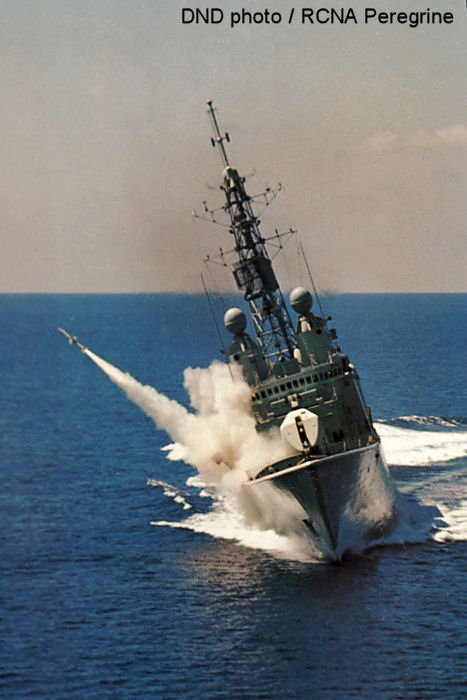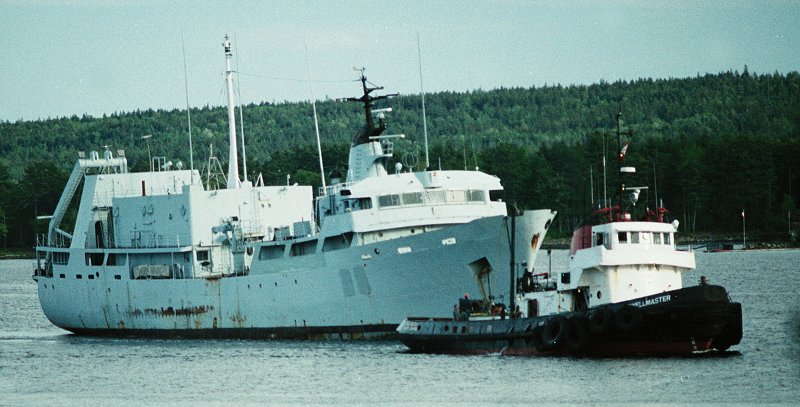Warships have large electrical power requirements, in order to run everything from heating and the lights, to galley equipment, electric fire pumps, sensors, and weapons systems. On IROQUOIS class destroyers, the Auxiliary Machinery Room (AMR) houses two 750 kW Solar Saturn gas turbine generators and one 1000 kW diesel generator to provide this power. A third 750 kW Solar Saturn is located forward of the bridge at deck level, in the port side of the deckhouse that formerly housed the Sea Sparrow launcher pre-TRUMP. If truth be told, I managed to get myself completely turned around in the AMR, and didn't take enough video and wide shots to help properly orient myself in the photos that follow, so some of my typical directional commentary will be lacking in this post. I didn't get a clear picture in my head of where each piece of machinery is located.
 |
| Looking down into the lower level of the AMR. Port propeller shaft at left of ladder. The AMR is a very crowded space that houses a variety of equipment, not just the generators. |
In the 1960s when the IROQUOIS class was designed, gas turbines provided the best "bang for the buck" in terms of high power from a compact package, so the Solar Saturns are the primary power source. As with the propulsion engines, all the generators are housed within skin-tight enclosures that serve to insulate the surrounding space from noise and, in extreme events, fire. They are also generally shock mounted, but I have no specific details regarding this.
 |
| The Solar Saturn gas turbine generator in the main engine room with the cover rolled back. |
The two Solars in the AMR are located port and starboard on the upper level of this space. During the time of my tour, two of the three Solar Saturns onboard had been dismantled and transferred from IROQUOIS to ATHABASKAN for spare parts on the latter ship. ATHABASKAN is the last remaining IROQUOIS class destroyer remaining in active service, and was on deployment at the time of this tour.
 |
| No.2 Solar Saturn gas turbine generator, looking forward in the AMR. |
Possibly to hedge their bets, a diesel generator was also included (originally a 500 kW Fairbanks Morse opposed piston engine, replaced during TRUMP by a 1000 kW Detroit Diesel). It is installed at the forward end of the AMR's lower level, between the two propeller shafts. The local control switchboard for this generator was retrofitted during the TRUMP refit, to accommodate the larger 1000 kW generator.
 |
| The diesel generator sits inside this enclosure, the interior of which doesn't appear quite as easy to access as the rolling enclosures for the Solars. |
 |
| 1000 kW diesel generator inside its enclosure through an open port. |
 |
| Local control switchboard for the diesel generator. Built in 1987, this would have been a retrofit during the TRUMP refit. |
All the electrical power on the ship is routed through the main switchgear, which is located elsewhere in the ship.
 |
| Main switchgear compartment. |
As with the propulsion gas turbines, all the generating equipment is controlled remotely in the Machinery Control Room (MCR) which I will cover in a subsequent post on this blog.
Correction: Previous versions of this post were mistaken in the location of all three Solar Saturn generators. In fact, only two are located in the AMR (upper level), and the third is located at deck level in the deckhouse forward of the bridge. Many thanks to members of various Facebook groups for setting me straight.





















































